Last updated on March 23rd, 2024
Featured image: Shirley Strum srrounded by Baboons in Kenya | Photo provided by Shirley Strum
In the circle of life, baboons are indispensable but misunderstood
by Rupi Mangat
In 1972, American Shirley Strum hopped off the plane in Kenya to study baboons for her PhD. The idea was to complete her field study, collect her data and return home to the US. But she got so intrigued by the primate that 51 years later, she’s still here, studying baboons in Kenya.
Baboons are the largest non-human primates on the savannah next to their primate cousin, human beings. These big-bodied hairy baboons are thriving and are found almost everywhere in sub-Saharan Africa. While they are fun to watch, they have a reputation as a smart crop- and livestock-raiding pests that do not endear them to farming and herding communities who live alongside them.
Yet, in the circle of life, baboons are indispensable. Baboons are the savannah’s gardeners. They disperse seeds and weed out sedges that enable fresh grass to grow for the livestock and the millions of herbivores from the African rhino to the antelopes to graze on.
Read: Almost Human: A Journey into the World of Baboons by Dr Shirley Strum.
Walking with baboons in Kenya
As the founder of the Uaso Ngiro Baboon Project (UNBP) in Kenya, Dr. Strum has developed community projects that employ local research assistants and support nursery, primary and secondary schools.
“We employ “trackers” to notify herders and bomas that the baboons are nearby so they can chase them away,” she says.
UNBP has launched several eco-tourism projects at Twala-Tenebo Cultural Village near ll Polei with the local women. Twala-Tenebo features Maasai-inspired cabins and a campsite for tourists. The women sell Maasai beaded jewellery, freshly harvested honey and introduce visitors to their way of life such as getting water and firewood, milking the livestock and beading. Visitors also interact with Maasai blacksmiths, a dying profession as few local youngsters are interested in the craft.
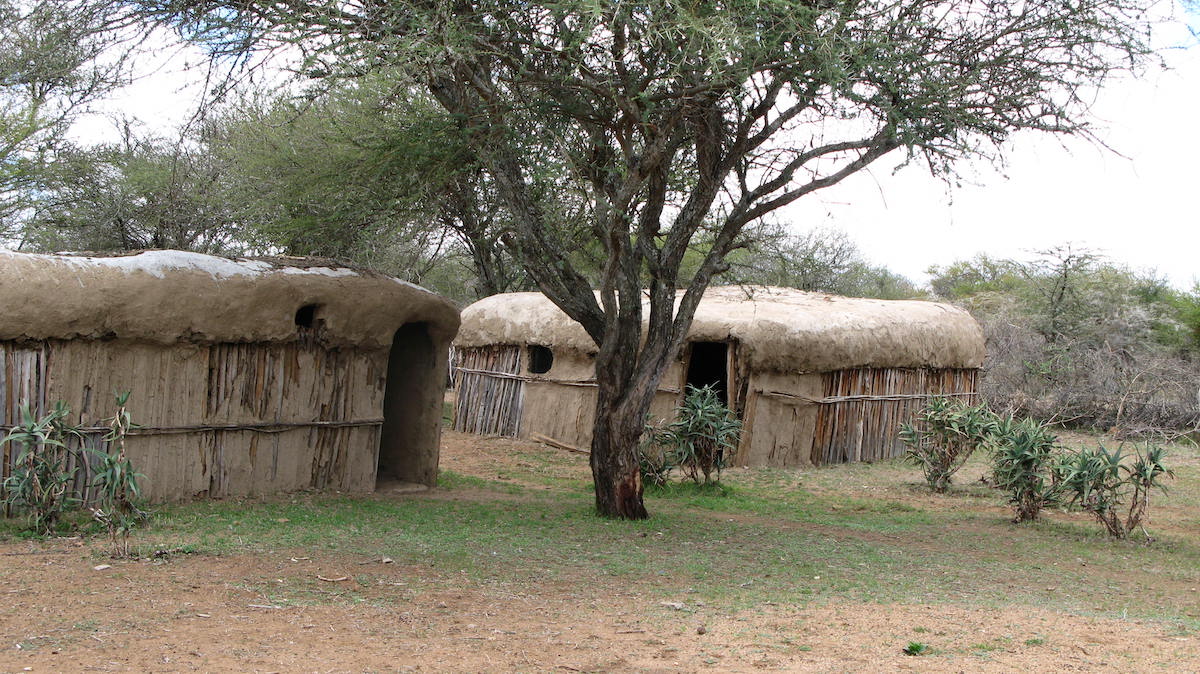
Twala traditional Huts in Kenya / Photo by Shirley Strum
“It’s given a new lease of life to the women, traditionally dependent on their husbands,” she says. “Local school children are taken on field visits and engaged in discussions on baboon behaviour and conservation with some school leavers employed by UNBP as researchers.”
Akin to the famous gorilla trekking in the Virunga mountains straddling Rwanda and Uganda, tourists are carefully guided by the Maasai women, trained by UNBP. The Maasai women like Rosemary Nenini know the baboons in a habituated tourist troop and they recognize her. Without her, the baboons would run away because new people are unfamiliar and frightening.
The tourists are briefed on the strict protocol to follow – you keep a distance, no noise, no food but just enjoy the company of the baboons from within the group because they are fascinating and amusing to watch.
Shirley also initiated ‘Walking with Baboons’ at high-end tourist lodges like Il Ngwesi near Samburu and Shompole Wilderness in southern Kenya.
A chat with Dr. Shirley Strum
Q. Shirley, how did you come to study baboons 50 years ago?
A. I was a freshman at the University of California Berkeley in 1965 and as an undergraduate at Berkeley, I looked for a scientific way to study human behaviour.
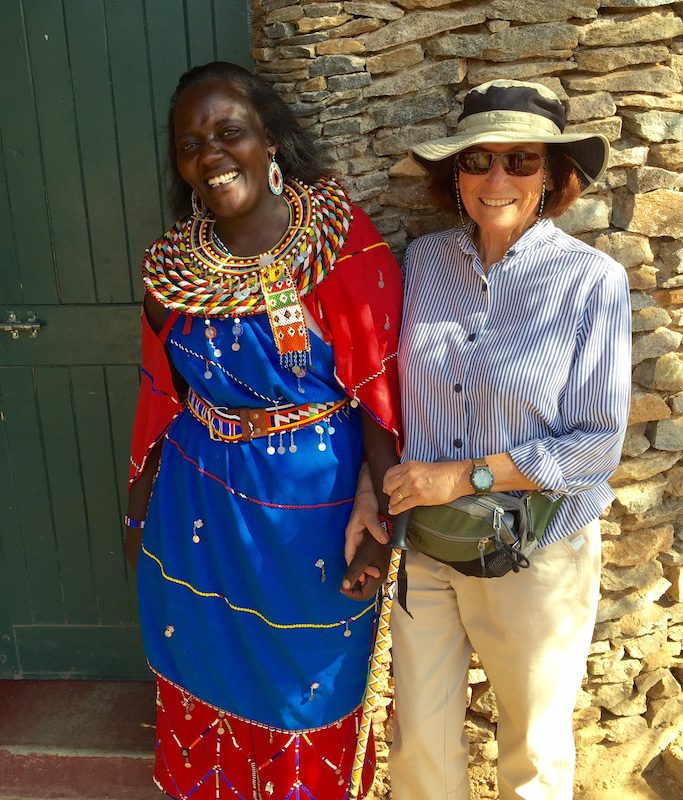
Shirley Strum and Rosemary Nenini the baboon trekker / Photo by Shirley Strum
I wanted to test a popular model that used baboons because only a few primates, including humans and baboons, have left the safety of the forest for the open savanna. My professor said that scientists should watch how primates move and behave in their natural environment to understand fossils and to reconstruct the behaviour of earliest humans.
Q. Tell us more about baboons!
A. They are very intelligent. They are the most successful non-human primate in Africa and initially offered insights into how early humans survived five to six million years ago.
While I began in the 1970s to use baboons as models for early human evolution, what I’ve learned helps me to redefine what is unique about humans. I’ve learned that many of the skills we assign to humans are already there in baboons.
For example, baboons make friends and have ways to get what they want without aggression. They have politics, even sexual politics. What baboons don’t have are symbols, language, tools/technology –what we normally call “culture”. Since I have to assume that the earliest humans were as smart as these baboons, this position resets the starting point of human evolution.
Humans took social and cultural skills further with our bigger brain, social cooperation, more diverse social emotions like jealousy and shame and tools that became technology. Baboons are smart but humans are smarter!
Q. What has your research revealed?
A. That baboons live more socially complex lives than we give them credit for. My findings were rejected by many scientists at the time because baboons were supposedly ‘mindless’ creatures. Today we accept that animals have emotions and minds, dramatically different from 50 years ago when I began.
Q. Share some ground-breaking insights in your baboon research
A. When two males fight, the losing male might leave and then return to the winner with a very young infant, a ‘black baby’ on his belly. That turns off the aggression of the other male because the troop doesn’t defend large males but it does defend females and infants, so if the opponent continues his aggression, he will get mobbed by the troop. Not a nice experience and a lesson learned immediately. But there is a catch. The troop mobs the male at whom the baby screams so to use an infant successfully as a “buffer” the male needs to develop a friendship with the infant first so he isn’t the one the baby screams at.
An infant is born black and stands out from the olive colour of the rest of the group. We think the black colour is a super stimulus attracting the attention of many of the group. However, at this point the infant already senses who is safe and who might be in trouble based on his mother’s reaction to others. When an adult male makes friends with a black infant, he now has options that don’t involve aggression and which rely on intelligence and social skills. At seven months, the black baby turns brown/olive like the rest of the troop. It’s a social strategy of defence.
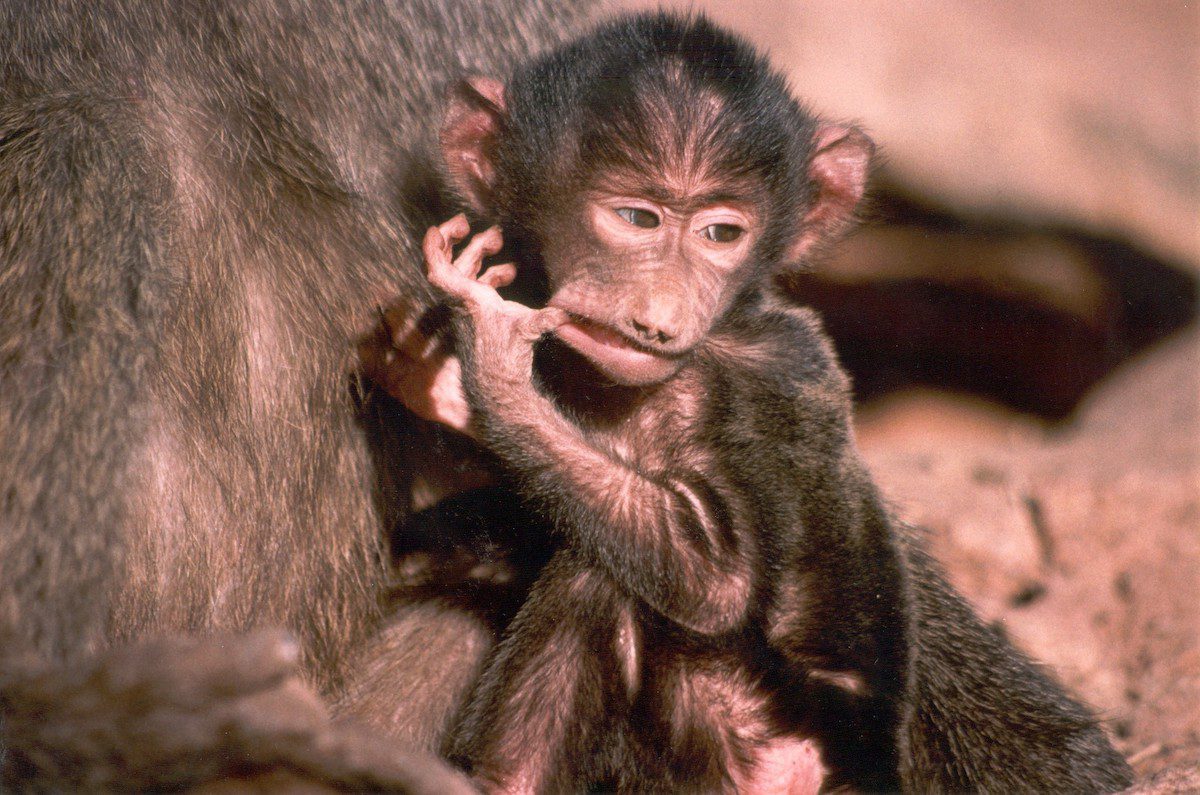
Black baby gorilla / Photo by Shirley Strum
Friendship also occurs between females and males as well. This pays off in competition for mating. A female prefers her male friend and stays close. Rape doesn’t exist among baboons so a male might monopolize a female but get no copulation. Investments in friendships pay off for each partner as the other reciprocates. Males become great babysitters for females and their infants, females reciprocate by grooming the male and cooperating in mating.
Q. You had to move a whole troop from your first study site. Why?
A. That was in 1984. The move was necessary because Kekopey, the cattle ranch, was sold to an agricultural cooperative. Pressure on land was just starting in Kenya and owners of small shambas (farms) tried rainfed agriculture in what was actually a rangeland. This increased the conflict between the baboons and people as baboons liked the new crops available in what was their traditional home range.
The troop was moved to Mukogodo (near Il Polei), a remote part in northern Kenya, 200 kilometres from the original site. It was the first translocation of its kind in the world.
In their new home in the arid land where the local communities engage in livestock herding but not farming, the new arrivals encountered the local baboon troops.
The local baboons when they were stressed as during the end of a very bad dry season or in droughts took to raiding but this time it was a young goat or later even a young sheep. Since males migrate between troops, the new arrivals could learn from the local baboons how to raid particularly when herds were roaming widely attended by young children.
The conflict between baboons and us is mainly over human food, including trash when thrown away carelessly. Once they have tasted human food, they know its attraction. In some countries including Kenya, whole troops are killed.
There is no easy solution to solve this. But if we want to co-exist and avoid conflict, then it comes down to fostering better understanding between humans and baboons. Most wildlife-human conflict problems are because of bad human behaviour but the animals always pay the price.
This was the impetus for the translocation and changing the name to the Uaso Ngiro Baboon Project in 1984 (the Uaso Ngiro is the river that flows through the northern arid land). It is the first primate project in the world to work with local communities, pioneering community-based conservation (CBC) to address the problem of raiding baboons and the arising human-wildlife conflict. Today this is a widely used model in conservation.
More about baboons in Kenya
Baboons are omnivores and eat anything including Opuntia stricta, the invasive plant that they love and unfortunately help disperse along with humans, livestock, and elephants.
The fruit of the invasive plant is a large package of nutritious food, akin to crops. Because of the plentiful cactus fruit, female baboons now giving birth at four years of age instead of the standard 7 and a half and have babies in intervals of 13 months instead of the usual 2 years.
The big question: What effect is this going to have on how infants learn from their mothers and also on the landscape? This is what we are studying right now.
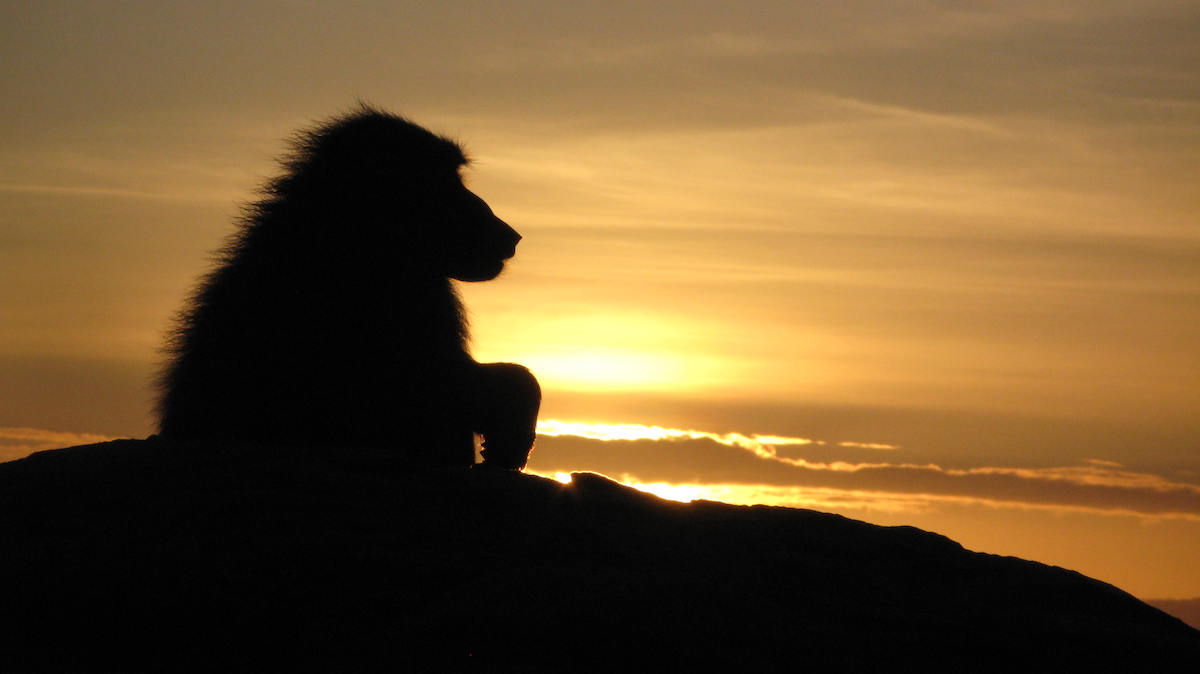
Baboons in Kenya at sunrise / Photo by Shirley Strum
More about primates
They are over 500 species, that include us (humans), great apes, monkeys, lemurs, bushbabies and others. All primates share larger brains (compared to other mammals), depth perception and colour vision, with flexible fingers to explore the environment with a hand and fingers, instead of a mouth. Another primate characteristic is social living and baboons are the most socially complex primate species besides humans yet described.
Being a Baboon
- Female baboons don’t leave their natal troop.
- Baboons have strongly bonded female-based families.
- Baboons make ‘friends’ be they other females, or females with males and infants with males.
- Males wander off to find a new troop several times during their lifetime.
- They practice ‘sexual politics’ exchanging social support for mating cooperation.
More Stories From Women in Africa
Meet the Woman Protecting Zimbabwe’s Majestic Lions: Moreangels Mbizah, the only Indigenous Black Woman Lion Conservationist in Zimbabwe
Across Africa, many communities feel alienated from wildlife, but through the efforts of Moreangels Mbizah, this perception is changing.
How Travel Changes Us: From Grieving Widow to Cheetah Crusader in Kenya
When Michele McCarthy was widowed, she turned to solo travel as a way to reinvent herself as a cheetah crusader in Kenya.
Kenyan Photographer Martha Mutiso Captures Mothers in the Wild
Kenyan photographer Martha Mutiso captures tender moments of Africa’s magnificent wildlife, celebrating mothers in all their forms.






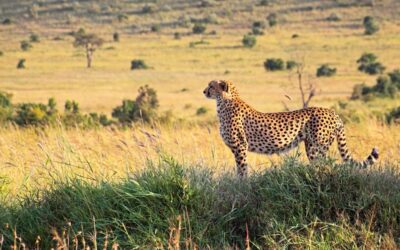
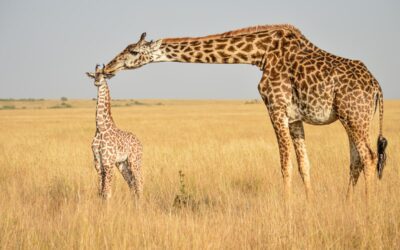
Hi Rupi, thank you for sharing the remarkable story of Dr. Shirley Strum. We all know of the tireless work of primatologists Dian Fossey, Birute Galdikas and Dr. Jane Goodall—I’m almost embarrassed to admit that I didn’t recognize such an accomplished baboon researcher. She’s made some really pivotal observations about male fighting tactics (how the losing male uses a young infant to deescalate a fight) and how the invasive cactus fruit is altering birthing patterns.
I remember my first up close baboon encounter in the Budongo Forest in Uganda while chimp trekking. The baboons are such tattletales! Like a farm dog, they start barking to alert everyone nearby that someone’s coming! Great interview–I’m going to dip into a few more that you’ve written.